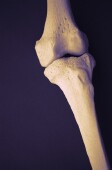Drug Fights Medication-Linked Bone Loss
Teriparatide may help asthma patients avoid fracture, researchers say.
By Ed Edelson
HealthDay Reporter
|
E-mail this article
Subscribe to news
Printer friendly version
|

(SOURCES: Kenneth G. Saag, professor, medicine and epidemiology, University of Alabama at Birmingham; Robert R. Recker, M.D., professor, medicine, Creighton University, Omaha, Neb.; Nov. 15, 2007, New England Journal of Medicine)
WEDNESDAY, Nov. 14 (HealthDay News) -- An osteoporosis drug has proven superior to standard therapy at slowing bone loss caused by asthma treatment, researchers say.
Glucocorticoid medicines such as prednisone are often given to treat asthma, autoimmune disorders, skin allergies and other conditions, researchers note. But the drugs can also cause osteoporosis.
The drug, an anabolic agent called teriparatide, probably will be the preferable treatment "for patients who have particularly bad disease to start with or are on glucocorticoids for a long time," said Dr. Kenneth G. Saag, professor of medicine and epidemiology at the University of Alabama at Birmingham.
The study, which was funded by teriparatide's maker, Eli Lilly & Co., is published in the Nov. 15 issue of the New England Journal of Medicine.
One million Americans are taking glucocorticoids for one condition or another, Saag said, and many are at higher risk of fractures, because the medications weaken their bones. Current treatment for medication-linked osteoporosis centers on use of bisphosphonates, medications designed to prevent bone breakdown.
The 18-month trial included 428 men and women with drug-caused osteoporosis who had been taking glucocorticoids for at least three months. Half were assigned to take alendronate, a bisphosphonate, while the other half took teriparatide.
After three months, the increase in bone density at the lumbar (lower) spine was double for those taking teriparatide -- an average 7.2 percent rise versus 3.4 percent in the alendronate group. The teriparatide group also experienced fewer fractures of the vertebral bones compared with those on the bisphosphonate.
But teriparatide's much higher cost will limit its use, Saag said. "Use of therapy is driven by insurance as well as by appropriate bone density and fracture rate," he said. "We would like to be able to single out those patients whose minimal bone density puts them at higher risk for fracture," Saag said. "Those patients are the ones we want to target more aggressively."
That group would include 30 percent to 50 percent of those with drug-caused osteoporosis, he said. The U.S. Food and Drug Administration already has approved use of teriparatide for the treatment of osteoporosis in postmenopausal women at high risk for fracture and to increase bone mass in men at high risk of fracture with primary or hypogonadal osteoporosis.
The anabolic agent is a better treatment, because bisphosphonates do not actually promote bone growth, added Dr. Robert R. Recker, professor of medicine at Creighton University and a member of the Osteoporosis Research Center there. Rather, they prevent bone destruction by natural processes such as apoptosis (natural cell death), he said
"There is a greater need for a bone-forming agent, one that interferes with the apoptosis of bone cells," Recker said. "The condition is not so much a low bone mass disease but a disease of bone cells that results in too much remodeling. Bisphosphonates lower remodeling. [Teriparatide] increases new bone formation."
But longer-term studies are still needed to assess teriparatide's effects over prolonged periods, Recker said.
"Not one study has gone long enough to see if you get more benefits by using it for a long time," he said. "It may be good for 24 months. That remains to be seen."
More information
There's more on medication-linked bone loss at the American College of Rheumatology. 
Copyright © 2007 ScoutNews, LLC. All rights reserved. 
HealthDayNews articles are derived from various sources and do not reflect federal policy. healthfinder.gov does not endorse opinions, products, or services that may appear in news stories. For more information on health topics in the news, visit the healthfinder.gov health library.